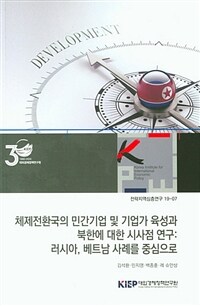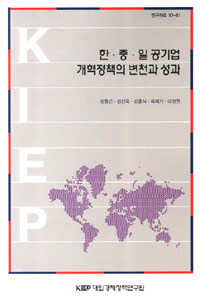
Promoting Dynamic & Innovative Growth in Asia: The Cases of Special Economic Zones and Business Hubs
- 발행사항
- Sejong : Korea Institute for International Economic Policy , 2016
- 형태사항
- 339 p. ; 23 cm
- 총서사항
- Policy Analysis
- ISBN
- 9788932216690
- 청구기호
- 322 PA16-01
소장정보
| 위치 | 등록번호 | 청구기호 / 출력 | 상태 | 반납예정일 |
|---|---|---|---|---|
이용 가능 (1) | ||||
| 1자료실 | G0016231 | 대출가능 | - | |
- 등록번호
- G0016231
- 상태/반납예정일
- 대출가능
- -
- 위치/청구기호(출력)
- 1자료실
목차
Preface
Chapter 1. Introduction - Are SEZs and Business Hubs the Best Tools for Development?
(Douglas Zhihua ZENG and Hyung-Gon JEONG)
1. Special Economic Zones
2. Business Hubs
3. Structure
4. SEZs and Business Hubs Are Contextualized Policy Tools
Chapter 2. Special Economic Zones as a Tool of Industrial Development :
case of Masna FTZ in South Korea (Hyung-Gon JEONG and Jong-Hun PEK)
1. Introduction
2. Expot Processing Zone as a Tool of Idustrialization:
Case of Seven Zones in South Korea
2-1. Background
2-2. Evaliation of the FTZ Policy in South Korea
2-3. The Sucess Factors of Masan FTZ
2-4. Challenges Regarding Continued Success
Chapter 3. Free Economic Zone as a Tool of Transition to an Innovative Economic Growrh:
Case of IFEZ on South Korea (Hyung-Gon JEONG and Jong-Hun PEK)
1. Intoroduction
2. Incheon Free Economic Zone: Its Performance and Future
3. Evaluation of Incheon Free Economic Zone (IFEZ)
3-1. Evaluation of Development
3-2. Evaluation of FDI Attrction
4. Possible Measures for Success of IFEZ
4-1. Improving Comprtitiveness by Attracting More Domestic Firms
4-2. Consolidation though De-designation
4-3. Srengthentiong Linkiage between SEZ Policy and Overall Industrial Development Policy
5. Key Lessons Learned from korean Special Economic Zone Policies
5-1. Offering Overarching Development Strategy and Vision for SEZs
5-2. Designation of SEZs Should Be Based on Economic Demand
5-3. Reducing the Overlaps among SEZs
5-4. Establishing an Efficient Governance System
5-5. One-Stop-Shop Service and Customized Support
5-6. Building an Outcome Ebaluation and Exit System
Appendixes
Chapter 4. Innovation and structural Transformation: The Case of Shanghai Free Economic Zones and Free Trade Zones(Guangwen MENG and Douglas Zhihua ZENG)
1. Economic Development in Shanghai
1.1 The Rapid Growth of Economy
1.2 Service-oriented Industrial Structure
2. Development of Shanghai Free Economic Zones
2.1 Phase of ETDZs(1984-1990)
2.2 Phase of Comprehensive FEZs(1991-2012)
2.3 Phase of ETDZs(1984-1990)
3. Successes and Challenges of Shanghai FEZs
3.1 Factors Leading to Success of Shanghai FEZs
3.2 Challenges Faced by Shanghai FEZs in Its Development
4. The Major Lessons Learned
Chapter 5. Invitation Strategy for cutting Edge Industries through MMCs and Global Talents: The Case of Singapore (Kim Song TAN)
1. Introduction
2. Business Hub MNCs: 1960s to Late 1990s
3. Business Hub for Global Creative Talents: From Early 20000s tod Date
4. The Singapore Experience: Success Factors and Lessons
5. Conclusion
Appendix
Chapter 6. Hong Kong 's Business nad Financial Hub Development: Factors, Challenges and Policy Implications(Yan DONG)
1. Introduction
2. Profile of Hong Kong Business and Financial Hub
3. Hong Kong Financial Sector's Development History
4. Key Factors for Success
4.1 Policy Factors
4.2 Internal Factors
4.3 External Factors
5. Challenges Regarding Continued Success
5.1 Regional Challeng from Other Business and Financial Hubs
5.2 Trade Modes Changing and Prevalent of Intra-firm Trade
5.3 Industrial Hollowing and Comparatively Slow Economic Growth
5.4 Economic Independence
6. Key Lesson Learned
6.1 Innovation and IndustrY Promotion Polices are Important
6.2 Free Market Environment Invigorates the Economy
6.3 Sound Legal System and Effective Regulation Policies Should Be Adopted
6.4 Fair Competition are Embodied in Economic Policies
6.5 Skilled labor and Talented Professionals are Crucial to Industry Development
6.6 Improving the Autonomy of the Economy
7. Policy Implications
7.1 Foster and Innovation-led Growth Mechanism
7.2 Further Optimize Free Market Economic Environment
7.3 Promote Manufacturing Sector Development
7.4 Construct a Politically Stavle Society
7.5 Strengthen Economic Relations with Mainland China
7.6 Provide Better Physical Infrastructure
7.7 Harmonizing the Relation between Hong Kong, Shanghai and Beijing
Chapter 7. Building a Successful Logistics and Production Hyb: The Case of Dubai Special Reference to the Jebel Ali Free Zone (Sherif MUHTASEB)
1. Introduction
2. Profile of Dubai and the JAFZ
3. Background and History of Zones in Dubai
4. Key Factors for Success
5. Challenges for Continued Success
6. Key Lessons
7. Policy Implications
Chapter 8. Policy Implications of SEZ and Business Hub Development in Asia(Douglas Zhihua ZENG and Hyung-Gon JEONG)
1. Key Elements of a Holistic Approach
2. A Sound LEgal and Institutional Framework
3. An Attractive Business Ebvionment
4. Careful Plannin, Design and Operations
5. Persistent Skills Training
6. Constant Technology Learning, Innovation, and Industrial Upgrading
7. Strategic Lovation and Strong Connectivity
8. Linkages With Local Economy
9. A Good Balance Between Industial Development and Social/Urban Development
10. A Monitoring, Evaluation, and Exit System
11. Som Factors Specific to SEZs or Business Hubs
12. Conclusion
Reference
Executive Summary









